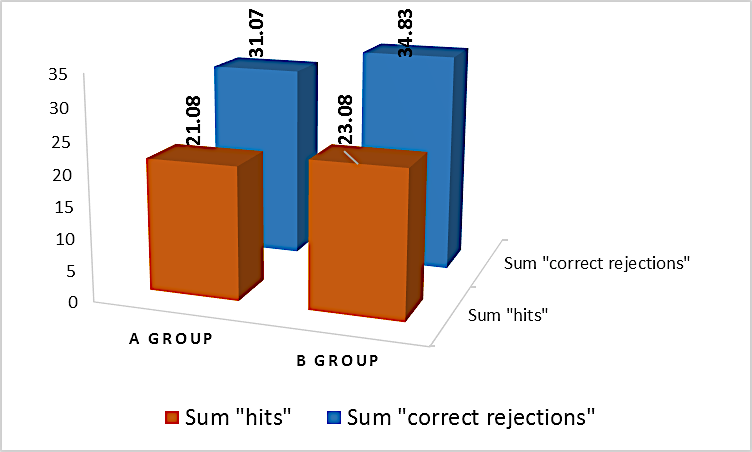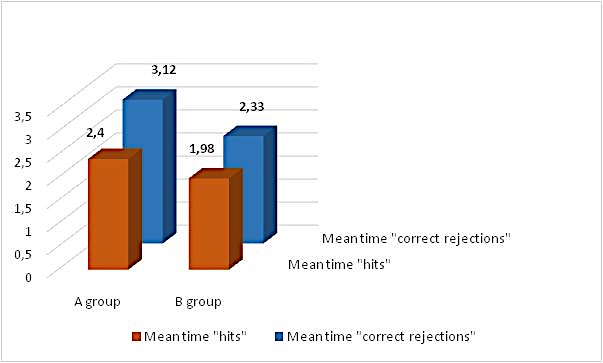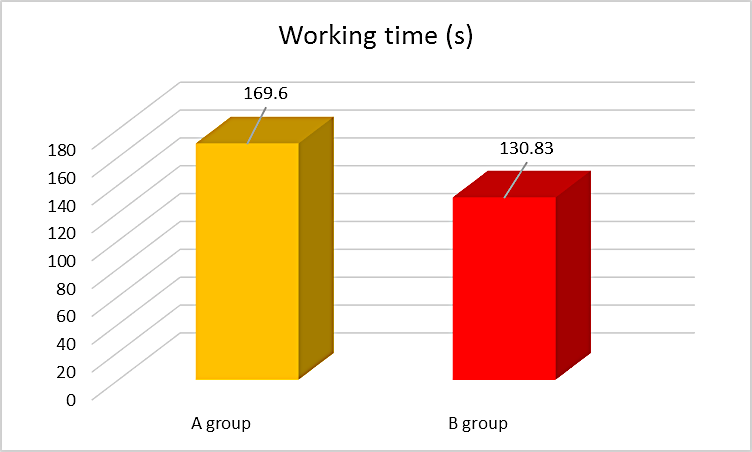Abstract
Learning disorders cause different academic problems for children. The task of teachers is to help to overcome these problems. 13 – 15 years old Latvian students with diagnosed learning disorders and control group students from Jūrmala school in Latvia which practices inclusive education were tested using Vienne Test System (VTS) tests and surveyed about their learning motivation and feeling in school. The VTS Cognitron test was used for assessment attention and concentration abilities and VTS Ravens Standard progressive matrices test was used in order to evaluate non-verbal general intelligence of students. It was found that attention and concentration abilities and IQ of students with learning disorders were lower in comparison with control group students. Many students with learning disorders have a more serious attitude towards school attendance than control group students. The opinion of teachers, classmates and parents about their learning achievements are very important for students with learning disorders. The overall mood at school was similar in students with learning disorders and control group students. Effective measures of inclusion and support for children with learning disorders enables them to feel happy and content at school and increase their learning motivation.
Keywords: Learning disorderspsychophysiological peculiaritiesstudentsmotivationpossibilities to concentrate
Introduction
Learning disabilities (LD) describe a large group of individuals who have significant academic learning deficits despite average or higher than average intelligence (Lawrence et al, 2014). LD can refer to deficits in several domains including reading disabilities, difficulties learning and understanding arithmetic, and disabilities of written expression. LD is not a homogeneous disorder. While over the past decades, much research has been conducted in the field of LD, there is much disagreement and controversy about definition of LD and diagnosis, assessment and treatment of LD, intelligence of children with LD, causes and mechanisms of LD. The important task of teachers and researchers in this field is to find the best methods to overcome difficulties children with LD experience at school and to help them to succeed academically.
Problem Statement
LD refers to a condition in which a child fails to develop adequate academic skills, such as reading, writing, or calculation. A certain level of academic achievements is expected based on the child’s level of intellectual functioning; deviations from the expected level are regarded as indicative of LD. Although most children with LD do not show clear evidence of brain damage using standard brain imaging techniques, there is evidence that children and adults with LD have differences in activation patterns and brain structure in different brain regions, for instance in the anterior left frontal region and two posterior left hemispherical regions (Deutsch & Davis, 2012).
Problems of people with LD and opportunities to solve them.
People with LD are likely to experience the complete spectrum of mental health problems throughout their lives and have different behavioural problems (aggression, destruction etc.) and additional long term health problems and disabilities such as epilepsy and sensory impairments (Barber, 2015). Research suggests that the cognitive functions of children with either learning disabilities or attention deficit hyperactivity disorder (ADHD) or comorbid ADHD and LD are impaired (Huang et al, 2016). Investigations have shown that adults with LD have significantly poorer executive function, deficient time management abilities, accompanied with negative emotional response, and lower perceived quality of life in comparison to adults without LD (Sharfi, & Rosenblum, 2017).
The task of teachers is to help overcome the difficulties students with LD experience. Different approaches are used for solving this problem. Verbal or non-verbal cues and communication tools, understanding and empowerment are effective principles in the work with people with LD (Heslop, Macaulay, 2013). There are many differences between students with LD of the same academic cohort in their abilities, learning opportunities, interests, social status, previous knowledge, and emotional and physical development. Very often these children manifest their behaviour by showing lack of attention or motivation for learning, emotional problems, behaviour disorders, difficulty in developing life skills and problems in motor skills and coordination, decrease in intellectual skills, poor work ethic, difficulty in organising their obligations, etc. In order to solve these problems, schools organise additional classes for students who have learning disabilities and help students with LD (Memedi, Ramadani, 2015).
For example, the intervention program "Joy of Reading" was created based on learning principles that were proven effective among children with LD. It included intensive exposure to daily structured reading activities, encouraging pupils' involvement in various reading and writing activities. Additional components, such as systematic exposure to schema story discourse, linguistic enrichment and social values, were added through various activities. The intervention program helped students with LD adopt reading habits as an enjoyable way to spend time (Tovli, 2014).
Academic, social skills and learning motivation of students with LD and teacher education for students with disabilities
It has been found that students with dyscalculia score significantly higher on measures of intrinsic motivation than other disability types (Luna, 2013). Students with learning disabilities, who have been diagnosed with attention deficiency, exhibit lack of motivation, apathy, difficulty in scheduling and organisation and adherence to schedule (Isabel, 2016).
An important factor is social skills training for children with LD. Students with LD in inclusive classrooms appear to be at greater social risk and have lower social status than the average academic achievers (Mostert, 2013). Teachers perceived students with LD to be less socially skilled than average. Children with LD fell below their peers on measurements of social problem-solving ability and verbal ability. At the same time students with LD are sensitive to a negative attitudes towards them. Students' attitudes toward students with LD are different. It was found that those students who have formed friendships with their LD suffering peers, exhibit more positive attitude towards them. These results indicate the necessity to reinforce student self-image and to encourage the students to socialise with students who have LD, in order to strengthen the positive and favourable attitudes of students, which will have positive impact on the success of the integration of students with LD (Gonen, Grinberg, 2016).
Teacher education plays a significant role for students with disabilities. The general line in teacher education is teaching and learning across both general and special education (Cavendish, Espinosa, 2013). There is a need for early identification of LD in schools so that with early recognition and remedial intervention children can be helped to cope with their studies (Bandla et al, 2017). In order to create effective work environment with students with LD, teacher collaboration with parents is essential. Child development depends on cultural and individual factors, and a culturally sensitive understanding of child behaviour can ensure better results for teachers and guide researchers in developing more efficient intervention programs, particularly for children with LD (Cen, Aytac, 2017). Findings have highlighted the need for individually selected accommodations matched to students' with LD needs and academic contexts (Weis et al, 2016). In order to solve these problems, more information about children with LD is necessary: it is needed to understand their psychophysiological peculiarities, factors that improve their learning motivation and factors that cause aversion to studies, their mood at school etc.
Research Questions
3.1 Is LD connected with psychophysiological parameters of students?
3.2 Does LD influence students’ learning motivation and their feelings and mood at school?
Purpose of the Study
The purpose of the study was to evaluate psychophysiological peculiarities of children with LD, their learning motivation, reasons that cause aversion to learning and their feelings and mood at school.
Research Methods
18 Latvian students diagnosed with LD (Group A) and 18 students without LD (control group – Group B) were surveyed and tested using two subtests of the Vienna Test System (VTS). All students with LD had been diagnosed with a reading disorder. Some of the participants also had some other LD closely linked to reading disorders – writing disorders, difficulties to understand instructions etc. All participants were 13 – 15 years old. All students were from a school in Jūrmala, Latvia, where inclusive education is practiced and special support provided for children with LD. Specially developed tasks for children with LD are used in school and more time is given for children with LD for solving tasks, if it is necessary. Teacher assistants help teachers during lessons.
Psychophysiological parameters (ability to concentrate attention and non-verbal general intelligence) of students with LD were registered using VTS tests and compared with the same age and school students from control group. Surveys of both student groups about their learning motivation, reasons causing aversion to learning and mood and feeling in school were also carried out. Survey questions were developed as multiple choice, but instead of choosing one or more options, participants had to evaluate all options on a Likert-type scale ranging from 1 to 5. The data were processed using SPSS, version 20.
VTS Cognitron (COG) test
VTS Cognitron (COG) test (Schuhfried, 2017) was used for assessment of attention and concentration through comparison of figures with regard to their congruence. COG test consists of tasks where the respondent must compare different complex figures and make a decision about identity of said figures (see fig.

The S11 form of the COG was used in the study (60 tasks were given without time limit). In this program the respondent controls the speed at which the items are presented: the next item does not appear until a response has been entered. The test ends as soon as all the items have been completed. In COG form S11, 60 tasks are divided in 6 different groups of stimuli with different degrees of difficulty. After presentation of every 10 stimuli the group of stimuli is changed.
VTS Raven’s Standard progressive matrices (SPM) test
VTS Raven’s Standard progressive matrices (SPM) test (Raven et al, 2017) was used in order to evaluate non-verbal general intelligence through analysing non-verbal visuo-spatial thinking, spatial perception and attention. It is possible to assess one’s ability to perceive the parameters of the object (shape, size), commitment of separate parts of the object with integrity etc., with the SPM test. Logical thinking is necessary for finding these connections. The test is easily enforceable regardless of the cultural and educational level. The S4 form of the SPM test was used in the present study. 32 items were provided to each participant for analysis. Items were divided in 5 sets with different characteristics (set A – 3 items; set B – 4 items; set C – 9 items; set D – 9 items; set E – 7 items). The following parameters of SPM test were registered: 1) total correct reactions during test; 2) correct reactions during set A; 3) correct reactions during set B; 4) correct reactions during set C; 5) correct reactions during set D; 6) correct reactions during set E; 7) total working time of the respondent (in seconds); 8) intelligence quotient (IQ) of the respondent.
Findings
The results of VTS Cognitron (COG) test have shown that sum “hits” (correct positive answers where green button is pressed at required stimulus) was statistically significantly

Mean reaction time for “hits” as well as mean reaction time for “correct rejections” was statistically significantly (

The total working time during COG test was statistically significantly (

The results of Raven’s Standard progressive matrices test (SPM) have shown that control group students made fewer mistakes during testing in comparison with children with LD (see Table
The IQ calculated from the SPM test results was statistically significantly higher

Students learning motivation
Students’ answers about main reasons why they attend school are evaluated in Likert scale from 1 to 5 (1 – completely agree; 2 – rather agree; 3 – neither agree nor disagree; 4 – rather disagree; 5 – completely disagree with the statement). The mean response to each statement was calculated for students with LD and control group (see Table
More students with LD agree that they attend school because knowledge is necessary for life, because it is interesting in school, in order to achieve something in life, because parents require them to learn, because it is their duty to learn (
Students’ appreciation of statements about reasons, which motivate them to learn are evaluated in Likert scale from 1 to 4 (1 – yes; 2 – rather yes than no; 3 – rather no than yes; 4 – no) (see Table
Students’ answers about main reasons which cause aversion to school subjects are evaluated in Likert scale from 1 to 5 (1 – completely agree; 2 – rather agree; 3 – neither agree nor disagree; 4 – rather disagree; 5 – completely disagree) (see Table
Students’ mood and feelings at school
Students were asked to provide answers about their mood and feelings at school in Likert scale from 1 to 5 (1 – always; 2 often; 3 – sometimes; 4 – rarely; 5 - never) (see Table
Conclusion
Attention and concentration abilities of children with LD are lower in comparison with control group children. VTS results show that control group students work faster and more accurately in comparison with children with LD.
The IQ calculated from the VTS SPM test results is lower for children with LD in comparison with control group students. Non-verbal general intelligence of the examined students with LD is lower in comparison with control group students.
Many students with LD have a more serious attitude towards school attendance when compared to control group students. Students with LD are motivated to learn if teachers and classmates appreciate their knowledge but the negative attitude of parents and classmates towards the student are the most important factors for students with LD that could cause aversion to learning.
The feeling and mood of students with LD in school similar to control group students. Effective measures of inclusion and support for children with LD enables then to be happy and content at school and increase their learning motivation.
Conflict of interest
There is no conflict of interest that the authors are aware of.
Acknowledgments
The authors would like to express their gratitude to the participating school in Jūrmala, parents who kindly consented to their children’s participation in the study, and Riga Teacher Training and Education Management Academy for support throughout all stages of the research.
References
- Bandla, S., Mandadi, G.D., Bhogaraju, A. (2017). Specific Learning Disabilities and Psychiatric Comorbidities in School Children in South India. Indian Journal of Psychological Medicine, 39(1), pp. 76-82.
- Barber, C. (2015). Caring for People with Learning Disabilities : A Guide for Non-specialist Nurses. eBook., Database: eBook Academic Collection (EBSCO host), 60
- Cavendish, W., Espinosa, A. Teacher Preparation for Student Diversity and Disabilities: Changing Roles in Response to Intervention Models. Learning Disabilities: Practice Concerns and Students with LD. Jeffrey P. Bakken, Festus E. Obiakor, Anthony F. Rotatori, (Ed.). Advances in Special Education, 25, 189-205.
- Cen, S., Aytac, B.| (2017). Ecocultural Perspective in Learning Disability: Family Support Resources, Values, Child Problem Behaviors. Learning Disability Quarterly, 40(2), 114-127.
- Deutsch, G.K., Davis, R.N. (2012). Learning Disabilities. Handbook of Medical Neuropsychology. Applications of Cognitive Neuroscience. Carol L. Armstrong, Lisa Morrow (Ed.). New York, Dordrecht, Heidelberg, London: Springer, pp. 237-250.
- Gonen, A., Grinberg, K. (2016). Academic Students' Attitudes toward Students with Learning Disabilities. Journal of Education and Training Studies, 4(9), 240-246.
- Heslop, P., Macaulay, F. (2013). What People with Learning Disabilities Say Helps Them. Understanding and Working with People with Learning Disabilities Who Self-injure. Pauline Heslop, Andrew Lovell (Ed.). pp. 71-79.
- Huang, F., Sun, L., Qian, Y., Liu, L., Ma, Q.G., Yang, L., Cheng, J., Cao, Q.J., Su, Y., Gao, Q., Wu Z.M., Li, H.M., Qian, Q.J., Wang. Y.F. (2016). Cognitive Function of Children and Adolescents with Attention Deficit Hyperactivity Disorder and Learning Difficulties: A Developmental Perspective Chinese Medical Journal, 129(16), 1922-1928.
- Isabel, C.D.M. (2016). From ADHD to psychosis… executive functions and time. European Psychiatry, 33, Supplement, 434.
- Lawrence, J., Lewandowski, J. & Lovett, B.J. (2014). Learning Disabilities. Child psychopathology. Third edition. Eric J. Mash, Russell A. Barkley. (Ed.) New York, London: The Gulford press, pp. 625-669.
- Luna, A.D. (2013). Predicting the Motivation in College-Aged Learning Disabled Students Based on the Academic Motivation Scale. Ph.D. Dissertation. The University of Arizona.
- Memedi, B.R., Ramadani, T. (2015). Organizing Additional Classes for Students with Learning Disabilities. Vizione, 23, 109-121.
- Mostert, M.P. (2013). Social Skills Training and Students with Learning Disabilities. Learning Disabilities: Practice Concerns and Students with LD. Jeffrey P. Bakken, Festus E. Obiakor, Anthony F. Rotatori, (Ed.). Advances in Special Education, 25, 87-112.
- Raven, J. C., Court, J. H. & Raven, J. (2017). APM Raven’s Advanced Progressive Matrices. Retrieved from: https://www.schuhfried.com/test/APM
- Schuhfried, G. (2017). COG Cognitrone. Retrieved from: https://www.schuhfried.com/test/COG
- Sharfi, K., Rosenblum, S. (2017). Executive Functions, Time Organization and Quality of Life among Adults with Learning Disabilities. PLOS ONE, 11(12), 1-15.
- Tovli, E. (2014). "The Joy of Reading" - An Intervention Program to Increase Reading Motivation for Pupils with Learning Disabilities. Journal of Education and Training Studies, 2(4), 69-84.
- Weis, R., Dean, E.L. & Osborne, K.J. (2016). Accommodation Decision Making for Postsecondary Students with Learning Disabilities: Individually Tailored or One Size Fits All? Journal of Learning Disabilities, 49(5), 484-498.
Copyright information

This work is licensed under a Creative Commons Attribution-NonCommercial-NoDerivatives 4.0 International License.
About this article
Publication Date
14 September 2017
Article Doi
eBook ISBN
978-1-80296-029-7
Publisher
Future Academy
Volume
30
Print ISBN (optional)
-
Edition Number
1st Edition
Pages
1-376
Subjects
Health, public health, preventive healthcare, preventive care, preventive medicine
Cite this article as:
Porozovs, J., Voita, D., Trubina, I., Voits, T., & Valdemiers, A. (2017). Psychophysiological Peculiarities And Learning Motivation Of Students With Learning Disorders. In Z. Bekirogullari, M. Y. Minas, & R. X. Thambusamy (Eds.), Health and Health Psychology - icH&Hpsy 2017, vol 30. European Proceedings of Social and Behavioural Sciences (pp. 205-216). Future Academy. https://doi.org/10.15405/epsbs.2017.09.19

